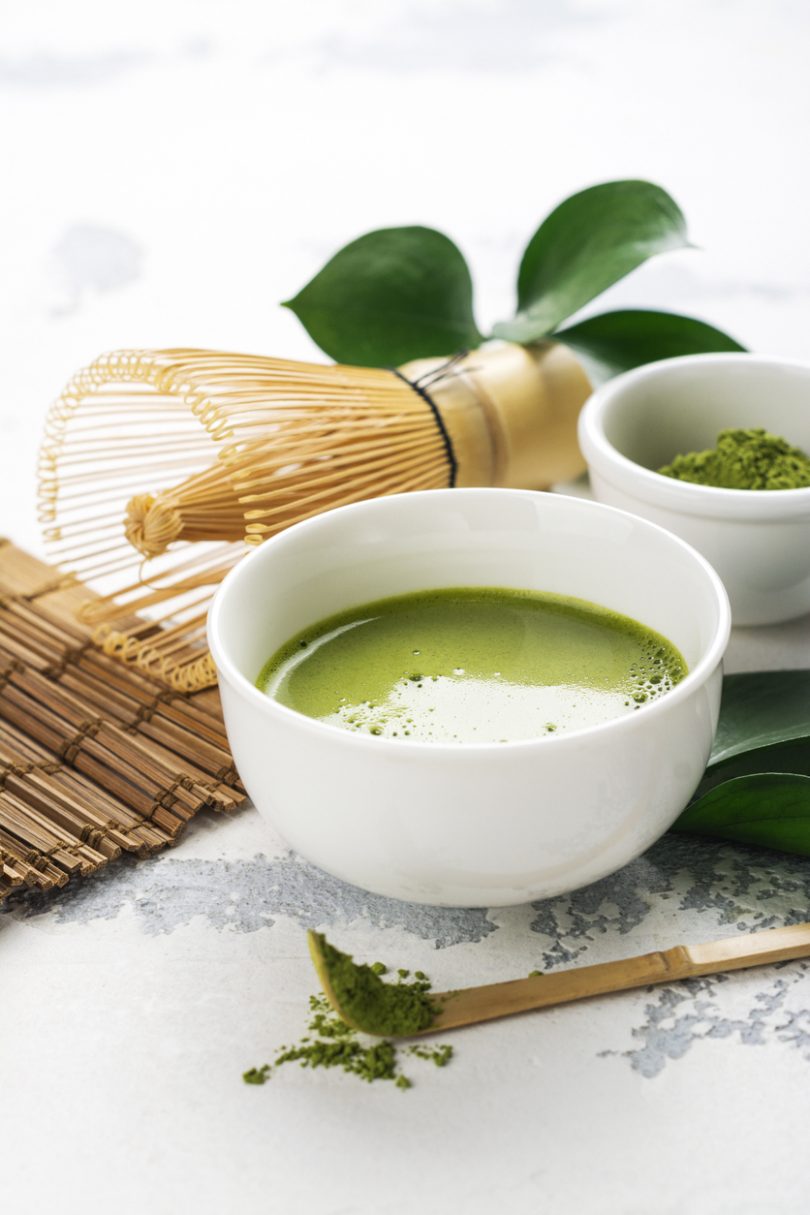Matcha, or whole leaf green tea, was used for centuries in Japan and is an integral part of Japanese tea ceremonies. Once consumed by Zen monks and Samurai alike, matcha has become an American coffeehouse staple — even Starbucks features a Matcha Latte — and is a popular alternative to coffee or steeped green tea, providing drinkers with a host of health benefits.
But what is matcha, exactly?
Matcha is Japanese shade-grown green tea leaves that have been dried, then stone-ground or crushed into a fine powder. When placed in hot water, the powder dissolves, and when whisked, a frothy, green elixir is formed. Traditional, steeped green tea filters out the leaves, thus infusing the water with tea leaves; whereas with matcha, the entire leaf — and the nutrients contained inside — is consumed. For example, matcha delivers over 100 times the amount of antioxidants found in standard green tea.
What does it taste like?
By itself, matcha is often described as having a grassy, earthy or spinach-like taste and smell. Never fear — a little honey or sweetener (and a dash of milk or non-dairy substitute) can quickly mitigate any unpleasant flavor. Using a handheld frother or blender helps to create a creamier texture and flavor that most people prefer. Also, the higher quality of powder you choose, the less bitter the matcha will taste. Look for terms such as “ceremonial grade” and “stone ground” to ensure quality and taste. And the brighter shade of green, the better it tends to taste.
What are the health benefits?
Matcha is full of powerful antioxidants including EGCG and other polyphenols, which have been shown to do everything from boosting metabolism and aiding in weight loss to protecting against heart disease, diabetes and high blood pressure. Research also shows that antioxidants such as those in matcha can help reduce inflammation, LDL (bad) cholesterol, cortisol (stress hormone) levels and cancer cell growth and alleviate arthritis symptoms. Additionally, matcha is said to help calm the mind, relax the body, enhance mood and aid in concentration — which monks used to their advantage in meditation.
Some studies also show matcha may even help keep your smile in shape by helping to regulate acid levels in the mouth and inhibit the growth of certain types of bacteria that cause cavities. Matcha also delivers a higher concentration of chlorophyll, vitamin C and other micronutrients as compared to traditional green tea.
Are there any risks?
Matcha does contain caffeine — nearly as much cup for cup as coffee. However, the energy boost from matcha produces what some call an “alert sense of calm,” thanks to L-theanine, a powerful mood-boosting agent that promotes relaxation without causing sleepiness. It’s no wonder people report using matcha to wean off coffee. Those sensitive to caffeine should approach matcha as with any caffeinated food or drink — be cautious and begin with a diluted serving size. If you don’t want to risk insomnia, especially don’t drink it after 5 p.m. You’ll also want to pay attention to the ingredient list — some store-bought matcha “beverage mixes” contain various additives, often using sugar as the main ingredient.
Ways to use matcha
Besides drinking simply as a tea, matcha powder can be using in baking and cooking. Try it in muffins and other baked goods; stir it into yogurt, smoothies or breakfast bowls. You can even incorporate matcha into savory dishes — try it in hummus, salad dressing or pasta dishes. Some grocers carry less-pricey cooking or culinary grade matcha. This powder will be darker in color and may not contain the same level of antioxidants and other health benefits as the more expensive ceremonial-grade type.
- 1 tsp. ceremonial-grade stone-ground Japanese matcha powder
- ¼ cup hot water
- ¾ cup warm milk or milk substitute
- 1-2 tsp. honey or packet of stevia
- In a mug, pour hot water over powder and stir vigorously until powder begins to dissolve.
- Add honey or sweetener and stir.
- Top with milk of choice.
- Optional: Use an immersion blender to create a froth or pour the drink into a small blender and then pour back into cup.

